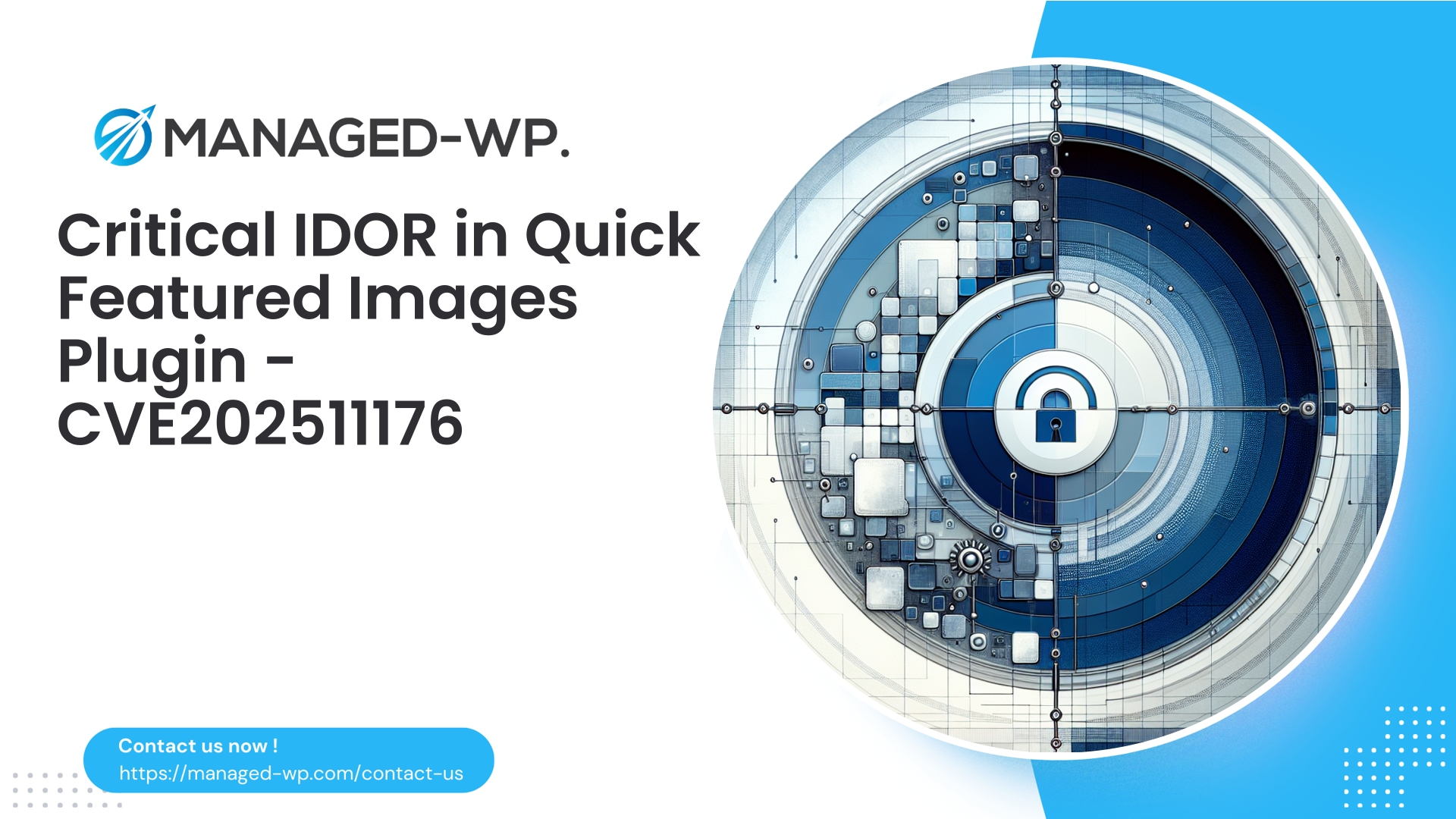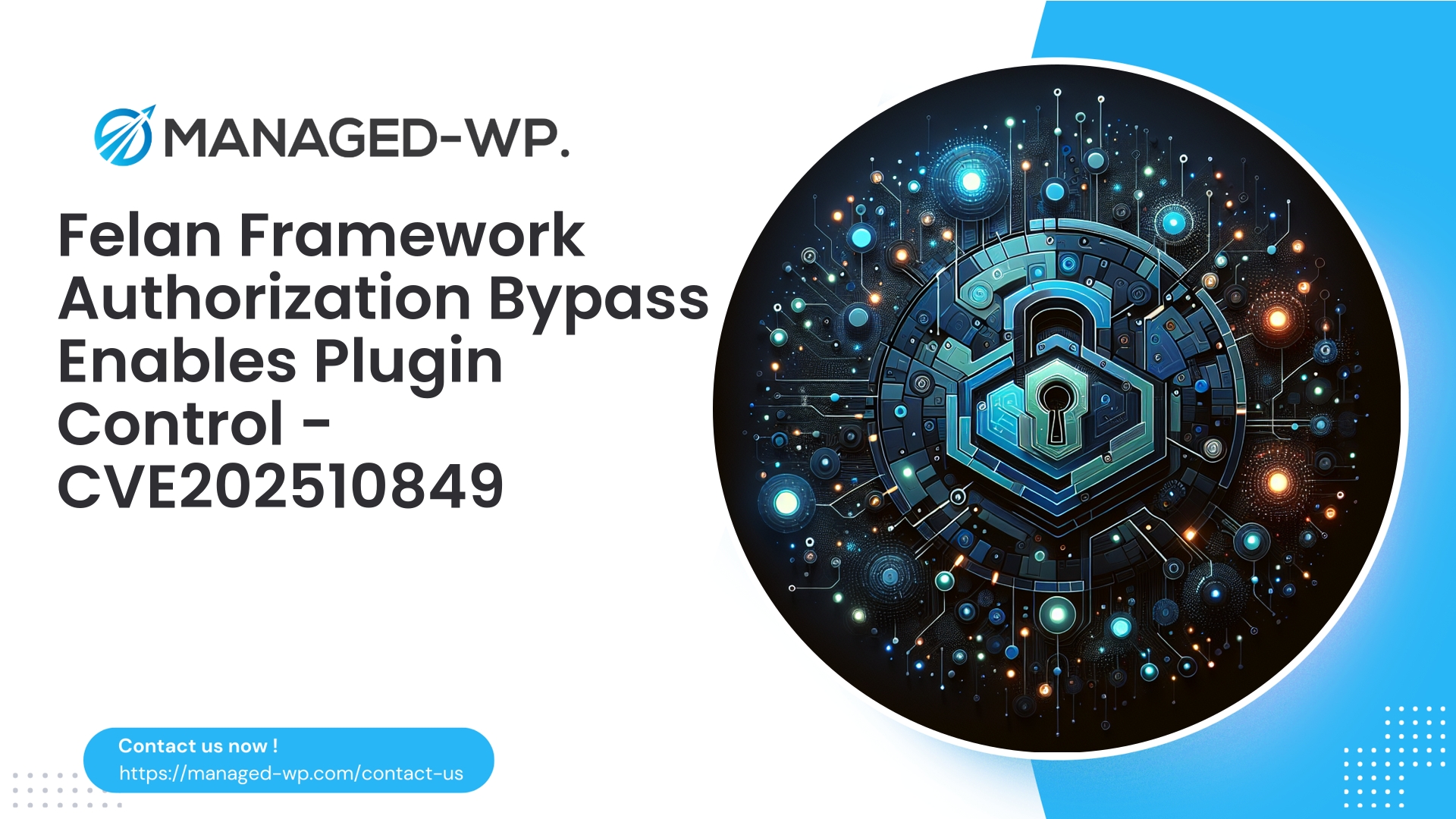| 插件名称 | WP Google 地图 |
|---|---|
| 漏洞类型 | 已认证的 SQL 注入 |
| CVE编号 | CVE-2025-11365 |
| 紧急 | 低的 |
| CVE 发布日期 | 2025-10-15 |
| 源网址 | CVE-2025-11365 |
紧急:WP Google Map(版本 <= 1.0)— 认证贡献者 SQL 注入漏洞 (CVE-2025-11365) — 网站所有者需立即采取措施
从美国网络安全专家的角度出发:深入剖析影响 WordPress Google Maps 插件 1.0 及更早版本的 SQL 注入漏洞,并提供切实可行的解决方案。了解风险、攻击途径、检测信号、即时缓解措施和强化防御措施。包含针对 WordPress 环境量身定制的虚拟补丁和防火墙规则建议。
作者: 托管 WordPress 安全团队
日期: 2025-10-16
标签: WordPress、安全、WAF、SQL注入、插件、事件响应
概述
安全研究人员已公开披露了一个严重的已认证 SQL 注入漏洞。 WP Google 地图 WordPress 插件(受影响版本 <= 1.0),被识别为 CVE-2025-11365该漏洞允许拥有贡献者级别或更高访问权限的攻击者将恶意 SQL 命令注入网站数据库,从而显著增加多作者 WordPress 网站以及任何授予非管理员用户写入权限的安装的风险。
作为您值得信赖的 WordPress 安全合作伙伴,Managed-WP 为您提供一份实用指南,内容涵盖:
- 该漏洞的技术细节和影响概述
- 利用过程中涉及的用户角色和权限
- 您必须立即采取的紧急缓解措施
- 如何有效检测出入侵迹象
- 用于立即进行虚拟修补的推荐防火墙 (WAF) 规则
- 插件维护者的安全开发最佳实践
- 长期强化建议以防止复发
- Managed-WP 的免费保护计划如何立即保护您的网站
本简报旨在为需要清晰、直接指导的网站所有者、管理员和开发人员提供指导——没有术语,没有废话。
漏洞利用概要:通俗易懂的解释
该漏洞源于在未进行适当清理或参数化的情况下,不安全地使用贡献者提供的 SQL 查询数据。贡献者通常可以添加和编辑帖子,但无权管理网站。然而,此漏洞使得已认证的用户能够构造专门设计的恶意代码,篡改数据库查询,从而可能读取或修改敏感的网站数据。
关键事实:
- 受影响的版本: WP Google Map <= 1.0
- CVE标识符: CVE-2025-11365
- 所需访问权限: WordPress 贡献者级别用户(或以上)
- 官方补丁: 截至披露时尚未公布
- 风险: 未经授权的数据访问、数据篡改、潜在的网站接管
贡献者级别权限:为何这尤其令人担忧
许多人认为只有管理员才拥有危险的权限。但事实并非如此简单。贡献者,尤其是那些作为内容创作者或社区成员而备受信任的人,也可能利用此漏洞执行恶意 SQL 命令来提升权限。这可能导致创建恶意管理员账户、数据泄露或植入后门——所有这些都能绕过常见的速率限制和账户锁定机制。
风险评估:您的站点是否处于高风险状态?
如果您运行的 WordPress 安装符合以下任何一项标准,请立即采取紧急措施:
- 已安装并启用 WP Google Map 插件,版本 ≤ 1.0
- 贡献者或更高级别的用户可以访问插件功能
- 最近添加或未经核实的贡献用户的存在
- 使用此插件的多站点或网络安装
即使没有立即出现安全漏洞的迹象,但经过身份验证的访问权限与已知的漏洞相结合,也需要立即采取缓解措施。
立即(一小时内)采取的步骤
- 禁用存在漏洞的插件:
- 暂时从 WordPress 控制面板停用 WP Google Map 插件。如果控制面板访问被阻止,请使用 FTP/SFTP 或 SSH 重命名插件文件夹(
wp-google-map到wp-google-map.disabled).
- 暂时从 WordPress 控制面板停用 WP Google Map 插件。如果控制面板访问被阻止,请使用 FTP/SFTP 或 SSH 重命名插件文件夹(
- 限制用户权限:
- 在调查期间,限制或暂停贡献者/作者角色。
- 审核并暂时中止过去 30 天内创建的、未经验证的账户。
- 立即启用WAF保护:
- 激活针对插件端点的 SQL 注入尝试的防火墙规则(详情如下)。
- 如果没有 WAF,请立即部署一个信誉良好的 WordPress 防火墙插件或服务。
- 备份您的网站:
- 创建完整的文件和数据库备份,并将其存储在异地或不可变存储解决方案中。
- 轮换敏感凭证:
- 如果出现安全漏洞迹象,请重置数据库密码、WordPress 安全盐值、API 密钥以及任何外部服务凭证。
- 加强监控和日志记录:
- 增加相关端点的日志记录,例如
admin-ajax.php以及插件钩子。 - 尽可能捕获可疑的 IP 地址、时间戳和有效载荷详情。
- 增加相关端点的日志记录,例如
- 通知您的内部团队和主机托管服务提供商:
- 与安全、开发和运营人员共享事件信息,以便协调应对。
识别剥削行为:线索和取证指标
SQL注入攻击可能非常隐蔽。请注意:
- 意外的管理员帐户
wp_users - 对选项键进行更改,例如
活跃插件,网站网址或小部件 - 未经批准引入的可疑文件或插件
- 未识别的计划任务(
wp_cron) - 更改用户角色或权限
用户元数据 - 来自贡献者 IP 地址的带有异常负载的管理员 AJAX 请求
- 与可疑外部 IP/域名的出站网络连接
例如,执行只读数据库查询作为取证措施:
- 最近添加的用户:
SELECT ID, user_login, user_email, user_registered FROM wp_users WHERE user_registered > (NOW() - INTERVAL 30 DAY); - 检查选项修改:
SELECT option_name, option_value FROM wp_options WHERE option_name IN ('active_plugins','siteurl','home'); - 列出已安排的任务:
SELECT option_value FROM wp_options WHERE option_name = 'cron';
如果发现异常情况,请保存日志和数据——立即联系事件响应专家。
开发者指南:如何修复和加固插件
最终的解决方案是更新插件代码,以消除不安全的 SQL 操作:
- 严格的输入处理:
- 切勿在 SQL 查询语句中连接未经检查的用户输入。
- 使用
$wpdb->prepare()用于 WordPress 中的参数化查询。 - 采用
esc_sql用于在必要时释放经过消毒处理的字符串。
安全查询模式示例:
global $wpdb; $search = $_POST['search_term'] ?? ''; $search = sanitize_text_field($search); $sql = $wpdb->prepare("SELECT * FROM {$wpdb->prefix}your_table WHERE title LIKE %s", '%' . $wpdb->esc_like($search) . '%'); $results = $wpdb->get_results($sql); - 能力检查:
- 使用以下方式检查用户权限
当前用户可以()在进行敏感操作之前。 - 不要仅依赖身份验证进行授权。
if ( ! current_user_can( 'edit_posts' ) ) { wp_die( '权限不足' ); } - 使用以下方式检查用户权限
- 随机数验证:
- 使用 WordPress nonce 进行表单和 AJAX 请求验证。
- 拒绝缺少有效 nonce 令牌的请求。
- 最小特权原则:
- 仅向具有相应角色的用户开放数据库相关功能。
- 输出转义:
- 对输出应用适当的转义,以防止跨站脚本攻击 (XSS) 和注入级联。
- 日志记录和警报:
- 跟踪服务器端的可疑参数和失败的 nonce 尝试。
推荐的 WAF/虚拟补丁规则
在官方补丁发布之前,通过 Managed-WP 的防火墙进行虚拟修补可以降低风险:
- 阻止插件 AJAX/admin 请求中的 SQL 控制字符和模式:
- 过滤包含关键字的对插件特定管理端点的请求,例如
联盟,选择,插入或者 SQL 注释序列。 - 只有在已验证的贡献者会话 cookie 和 POST 数据存在的情况下才会进行此阻止操作。
- 过滤包含关键字的对插件特定管理端点的请求,例如
- 白名单参数类型:
- 对数字或短字符串字段强制执行严格的格式要求。
- 例如:参数只允许长度不超过 10 的数字,例如
地图 ID.
- 验证引用页和随机数:
- 拒绝缺少有效 nonce 或 referer 标头的管理员 POST 请求。
- 行为分析:
- 限制贡献者过多的 POST 请求。
- 对可疑IP地址或异常请求模式发出警报。
- 块编码混淆:
- 检测并阻止嵌套或双重 URL 编码的有效载荷。
- 基于响应的阻塞:
- 当返回数据库错误消息时,阻止客户端的后续请求。
虚拟补丁必须进行调整以最大限度地减少误报:首先启用警报模式,分析日志,然后启用阻止模式。
事件响应手册
- 隔离受影响部位:
- 启用维护模式或阻止外部流量以减少进一步的损害。
- 保存证据:
- 在进行任何更改之前,请备份日志、数据库和文件。
- 轮换所有凭证:
- 评估安全漏洞后,重置数据库密码、管理员用户密码、WordPress 盐值和 API 密钥。
- 移除后门和恶意内容:
- 进行恶意软件扫描和人工审核。
- 从干净的备份恢复:
- 如果条件允许,回滚到已知良好的状态。
- 根本原因整改和强化:
- 应用代码修复、更新插件、强制执行最小权限原则并改进监控。
- 沟通要透明:
- 如果怀疑用户数据泄露,请遵守违规通知要求。
日志记录和监控建议
- 捕获所有 POST 请求的详细信息
admin-ajax.php以及插件端点:- 时间戳、用户 ID、IP 地址、用户代理
- 请求参数(屏蔽敏感内容)
- 警报信息:
- 多次 nonce 验证失败
- SQL注入关键字模式
- 来自单个贡献者账户的大量 POST 活动
将您的 Web 服务器日志与 WordPress 和主机日志进行关联,以识别横向移动和协同攻击。
数据库凭证:为什么轮换很重要
SQLi 成功会暴露敏感表,包括 wp_users 使用密码哈希。虽然哈希算法采用了强加盐技术,但离线破解仍然会威胁用户安全,尤其是在密码重复使用的情况下。如果发现可疑查询或数据盗窃迹象,请立即轮换数据库用户密码,并确保强制执行最低限度的数据库权限。
开发人员检查清单摘要
- 始终使用
$wpdb->准备数据库查询 - 对输入内容进行适当的清理(例如,
清理文本字段,区间) - 强制执行用户能力检查(
当前用户可以()) - 使用随机数保护请求并验证它们
- 限制输入长度和允许的字符数
- 实现服务器端日志记录,以检测异常输入
WAF/虚拟补丁:为什么在补丁发布前进行补丁准备至关重要
通过WAF进行虚拟修补可以起到有效的防护作用,在攻击尝试到达易受攻击的代码之前就将其拦截。虽然这不能替代正确的代码修复,但它可以为网站所有者争取宝贵的时间,以便安全地应用完整的补丁。
安全移除或更换插件
- 通过 WordPress 管理面板停用该插件。如果无法访问,请重命名该插件。
wp-google-map通过 FTP 或 SSH 上传插件文件夹。 - 仅当确定剩余的插件表或选项没有必要时才将其删除。
- 如果插件至关重要,请确保WAF保护已启用,并对代码进行严格审核。
事故后加固建议
- 对所有用户角色应用最小权限原则
- 为所有特权帐户启用双因素身份验证 (2FA)
- 限制插件访问权限,仅允许受信任的用户访问,并对所有输入进行清理。
- 按照经过测试的计划,保持 WordPress 核心、主题和插件的更新。
- 使用具有不可更改保留策略的自动备份。
- 定期进行恶意软件扫描和完整性验证
- 维护 WAF 或虚拟补丁层以防御新出现的漏洞
日志记录和警报阈值示例
- 当贡献者帐户每分钟向管理端点发出超过 5 个 POST 请求时触发警报。
- 针对包含 SQL 元字符和无效 referer 标头的重复 POST 请求发出警报
- 监控插件端点是否存在大型数据导出或长时间数据库查询的情况
常见问题
问: 未经身份验证的攻击者能否远程利用此漏洞?
一个: 不。利用此漏洞需要经过身份验证的贡献者级别(或更高级别)访问权限。
问: 是否有官方补丁可用?
一个: 披露时暂不披露。发布后立即采取缓解措施并更新。
问: 防火墙能彻底解决这个问题吗?
一个: 防火墙可以降低攻击风险,但不能替代打好补丁的安全代码。
典型漏洞利用时间线
- 贡献者精心制作恶意载荷,并通过插件界面或直接 POST 请求提交。
- SQL 查询语句构建不安全,执行后允许访问或修改数据。
- 攻击者可能提取用户或选项数据、插入管理员用户或触发后门。
- 利用计划任务或恶意文件建立持久立足点。
- 数据可能被窃取或攻击面可能扩大。
立即注册,享受托管式 WordPress 保护——基础计划(免费)
使用 Managed-WP Basic(免费)计划获得基本保护
为了在您快速评估此漏洞的同时保护您的网站,Managed-WP 的基础套餐提供了一套有效的防火墙,包含 WAF 虚拟补丁、恶意软件扫描以及针对 OWASP Top 10 的防御措施。此套餐免费、易于设置,并能立即缩小您的攻击面。
请在此注册: https://my.wp-firewall.com/buy/wp-firewall-free-plan/
对于自动删除、IP 黑名单、月度报告和自动虚拟补丁等高级功能,请考虑 Managed-WP 的高级套餐。
WAF与安全编码相结合的强大功能
仅靠安全代码或Web应用防火墙(WAF)是不够的。安全代码从源头上消除漏洞,而Web应用防火墙则实时阻止攻击尝试。两者结合使用可以大大降低攻击发生的可能性和影响。
来自您的托管 WordPress 安全团队的最终建议
- 立即禁用或隔离存在漏洞的 WP Google Map 插件。
- 部署 WAF 规则阻止针对插件端点的 SQLi 尝试;监控后调整并激活阻止模式。
- 减少并审核用户权限,特别是贡献者级别角色。
- 建立不可篡改的备份并保留日志以进行取证分析。
- 请勿在未修补 SQL 注入漏洞或未应用安全查询处理的情况下部署插件更新。
- 激活 Managed-WP Basic 免费计划,以便在修复期间获得快速防火墙保护。
结语
SQL注入攻击仍然是一个重大威胁,因为它可能直接破坏数据的完整性和机密性。由于存在需要身份验证的访问权限,因此WP Google Map的这个漏洞亟待解决。网站所有者和管理员必须迅速采取行动降低风险,同时等待官方修复。
如果您在部署这些防护措施时需要专家协助,或者希望 Managed-WP 立即为您的网站进行虚拟修补,请联系我们的团队。我们的托管 WordPress 防火墙服务旨在实现快速事件响应和持续防御。
保持警惕,定期更新备份,并严肃对待需要身份验证的插件漏洞。攻击者首先会攻击用户和信任层——不要让你的网站成为下一个受害者。
— Managed-WP 安全团队



















